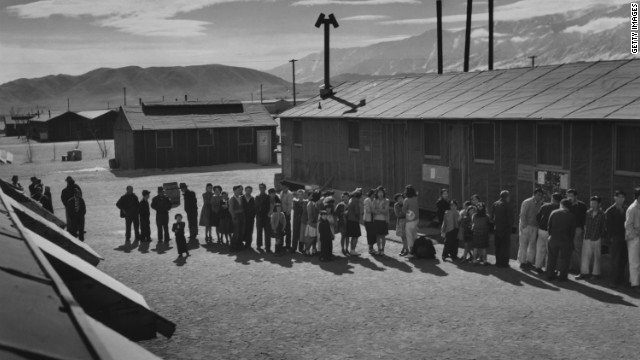ICC Office of the Prosecutor Weekly Briefing June 2012 Issue 123
From the very beginning of the revolution, the Assads have been the only party that had plans and contingency plans, and they are sticking to them. It seems we may not have to wait for long before an all-out cut-down-the-tall-trees moment comes in many mixed communities that the Assads want to see cleansed of their Sunni inhabitants. This is the story of a genocide that could have been averted.
By Pearl Rimon
Impunity Watch Reporter, Europe
MOSCOW, Russia — Russian parliament has approved a bill restricting the current law on public protests. The bill would increase the fines for protest participants to 300,000 rubles ($9,000), 600,000 rubles ($18,000) for organizers and peaking at one million rubles ($30,000) for legal entities. People could be fined for taking part in unsanctioned protests or for violations during sanctioned protests.

These proposed changes have moved through the upper chamber of Russian parliament, the Federation Council and the lower chamber of parliament, the State Duma with great speed and only await President Vladimir Putin’s signature in order to become law. President Putin has previously expressed his support for the bill which is backed by the United Russia party.
The bill was first introduced to the parliamentary chambers less than a month ago. The bill’s first reading occurred on May 22 and it had its third and final reading on June 5. It is believed that the fast track for the bill is due to the upcoming June 12 mass protest rally planned by opposition parties.
Despite the bill’s fast track into a law, opposition members of parliament did use delaying tactics in an attempt to postpone the vote on the bill. They forced a reading of each of the 300 amendments to the bill. During one of parliament’s sessions, 20 demonstators were detained for protesting. Demonstatrors say the proposed bill violates the 31st article of the Russian constitution, regarding the right to freely assemble.
This bill challenges the right to freedom of assembly. “Imposing large fines for violating rules on public events will have a chilling effect on peaceful assembly in Russia,” said Hugh Williamson, Europe and Central Asia director at Human Rights Watch. “The aim seems to be to curtail demonstrations rather than to properly regulate them.”
In December 2011, Russia experienced its biggest protests since the fall of the USSR. Nearly 50,000 people gathered in Moscow to protest, due to allegations of ballot-rigging after the parliamentary elections. Close to 1,000 people were arrested following the aftermath of this protest.
For further information, please see:
BBC — Russian Parliament Backs Huge Protest Fines — 6 June 2012
Human Rights Watch — Russia: Reject Restrictions on Peaceful Assembly — 6 June 2012
Deutsche Welle — Russian Bill Targeting Protestors Hits Snag — 5 June 2012
BBC — Russian Election: Biggest Protests Since Fall of USSR — 10 December 2011
By Mark O’Brien
Impunity Watch Reporter, North America
LOS ANGELES, California — The Los Angeles County Board of Supervisors voted Wednesday to right a 70-year-old wrong.

The supervisors unanimously repealed a 1942 resolution that supported the internment of Japanese Americans at the start of World War II.
“We were imprisoned behind barbed wire fences when there were no charges, no trial,” former “Star Trek” actor George Takei told the Los Angeles Daily News. He gave a moving presentation to the board supporting the repeal about his time in the camps when he was only five years old.
“It still stank of horse manure,” he said of the stables at Santa Anita Park, a thoroughbred racetrack, where he, his parents, and two siblings were housed. “My mother said it was her most humiliating and degrading experience up to that point, but more were to follow.”
Takei’s family was among the 17,000 who lived at the camp for several months before they were shipped to internment camps in northern California and southeast Arkansas.
“Our only crime was looking like the people who had bombed Pearl Harbor,” he said.
The board passed the resolution shortly after Japan’s surprise military attack on the U.S. naval base at Pearl Harbor, Hawaii. The bombing directly led to the American entry into World War II. At the time, the board hoped its resolution would urge President Franklin D. Roosevelt to move forward with the internment camps because the board felt it was difficult “if not impossible to distinguish between loyal and disloyal Japanese aliens.
Roosevelt signed Executive Order 9066 in February 1942, placing roughly 120,000 Japanese Americans in camps for up to three years. Nearly a third of them were in Los Angeles County. Thousands of people with German or Italian ancestry were also placed in the camps.
“The internment of American citizens of Japanese ancestry was, no doubt, a low point in American history,” said Supervisor Mark Ridley-Thomas, who introduced the motion to rescind the old resolution. “To ignore this and leave it as unfinished business is essentially to trivialize it, and we choose not to trivialize this travesty.”
Over the weekend, many Japanese Americans, who once were housed at Santa Anita Park, gathered there to reflect on the struggles and foster inspiration and healing.
“Every family that was put in the camps has a wide range of emotions,” event organizer Wendy Fujihara Anderson. “My parents never talked about the camps.”
President Gerald Ford proclaimed in 1976 that Roosevelt’s executive order officially ended when the war did. President George H. W. Bush issued an official apology in 1989.
Many who supported the board’s repeal said it was a long time coming, and a significant one at that.
“We (now) can face the future having extracted important lessons from our democracy,” Takei said.
For further information, please see:
CNN — L.A. County Board Repeals Support of WWII Japanese Internment — 6 June 2012
Contra Costa Times — Supervisors Repeal 1942 Act Supporting Japanese-American Internment — 6 June 2012
Los Angeles Times — County Supervisors Rescind 1942 Japanese American Internment Vote — 6 June 2012
Los Angeles Daily News — L.A. County Supervisors to Repeal 1942 Resolution Supporting Internment of Japanese Americans — 4 June 2012
San Gabriel Valley Tribune — Japanese Internment Recalled in Santa Anita; Heroes of Era Honored — 4 June 2012
ArcadiaPatch — Japanese-American Internment Camp Victims Remembered, Honored — 3 June 2012
By Margaret Janelle Hutchinson
Impunity Watch Reporter, South America
BRASÍLIA, Brazil – As Brazil prepares to host Rio+20, the United Nations Conference on Sustainable Development, president Dilma Rousseff is trying to set an example through legislation and other environmental projects, but environmentalists say her efforts don’t go far enough.

Activist and former Brazilian presidential candidate Marina Silva called Tuesday for protests matching the magnitude of Egypt’s Tahrir Square demonstrations at the upcoming environmental summit.
More than 100 heads of state and tens of thousands of participants from governments, the private sector and NGOs will converge on Rio de Janeiro from the 20th-22nd of June for the conference. Marking the 20th anniversary of the “Earth Summit” in 1992 in Rio de Janeiro, the Rio+20 gathering aims to break years of deadlock on pressing environmental issues and set up long-term paths toward green development and sustainability.
Late last month, President Rousseff partially vetoed a bill that would have weakened her country’s efforts to protect the Amazon and other forests. Legislators in both houses had passed a set of revisions to the Forest Code that threatened permanent preservation areas – a key provision in Brazilian environmental legislation – that obliged farmers to keep a proportion of their land as protected forests, particularly on the fringes of rivers and hillsides. Brazil’s powerful agricultural lobby has long opposed the preservation requirement.
Speaking on World Environment Day, Rousseff stressed that economic problems should not serve as a pretext to abandon efforts to safeguard the planet.
“The crisis can’t be an argument to suspend measures to protect the environment, much as it can’t be an argument to suspend policies of social inclusion,” Rousseff said.
Everybody from the Brazilian Academy of Sciences to, literally, the Brazilian equivalent of Bugs Bunny was saying ‘veto this bill completely,’ according to Steve Schwartzman, director of Tropical Forest Policy for the Environmental Defense Fund.
In the end, President Rousseff vetoed 12 sections of the bill. The most controversial clause would have given amnesty to all landowners that illegally deforested before 2008. Instead, Rousseff modified that section to only apply to small landowners. Congress has until mid October to discuss and vote on an amended version of the bill.
Many environmentalists see Rousseff’s actions as not going far enough. They feel that Rousseff is striking a precarious balance between powerful economic players and the future of the planet.
“This sends a bad signal on the eve of the Rio+20 when Brazil could have been an example,” Silva said. “If on the eve of the Rio+20 we practically eliminate the law that protects forests, we change the law that defines the boundaries of indigenous lands and we withdraw the capacity of a federal agency responsible for combating illicit deforestation… imagine what will happen,” she said.
Nevertheless, Brazil has made strides in forest preservation. Deforestation of the Amazon has fallen to its lowest levels since records began, according to data recently released by Brazil’s National Institute for Space Research.

Using satellite imagery, the institute said 6,418 sq km of Amazon forest was stripped in the 12 months before 31 July 2011 – the smallest area since annual measurements started in 1988.
“This reduction is impressive; it is the result of changes in society, but it also stems from the political decision to inspect, as well as from punitive action by government agencies,” Rousseff said.
She was speaking at a ceremony on Tuesday to mark the opening of two new nature reserves: the 34,000-hectare (83,980 acres) Bom Jesus Biological Reserve in Paraná, and the 8,500-hectare (20,995 acres) Furna Feia National Park in Rio Grande do Norte.
Likewise in advance of the Rio+20 summit the state government of Rio do Janeiro last week announced the closure of one of the world’s largest open-pit landfills, where thousands of people have made a living sorting the debris.
Long a symbol of ill-conceived urban planning and environmental negligence, the Jardim Gramacho dump is being transformed into a vast facility that will harness the greenhouse gases generated by the rotting rubbish and turn them into fuel capable of heating homes and powering cars.
Environmentalists had blamed Gramacho for the high levels of pollution in Rio’s once pristine Guanabara Bay, where tons of run-off from the garbage had leaked.
Despite these efforts by the government to make progress in environmental preservation and sustainability efforts, key activists are calling for large scale protesting and demonstrations during the Rio+20 summit.
“I hope that Rio+20 will become the Tahrir Square of the global environmental crisis and that international public opinion will be able to tell leaders that they cannot brush off the science,” Silva told AFP. “They cannot lower expectations in the face of a crisis worsening every day,” said the 53-year-old figurehead of Brazil’s environmental movement.
The Brazilian military plans to deploy 15,000 security personnel for the UN summit and a parallel “people’s summit” at the Flamengo park in southern Rio, which will be sponsored by civil society and is expected to see the attendance of nearly 20,000 people a day.
For further information, please see:
The Guardian – Amazon deforestation at record low, data shows – 7 June 2012
Merco Press – In anticipation of Rio+20, Brazil creates new nature reserves and closes major land-fill – 7 June 2012
iBahia – MP do Código Florestal será votada no Congresso até outubro – 6 June 2012
Public Radio International – On eve of Rio +20 environmental conference, Brazil’s president pushes back on forestry changes – 6 June 2012
Ahram Online – Brazil’s Silva calls for Tahrir-style demo at Rio+20 – 5 June 2012
The Guardian – Brazil’s leader vetoes portions of new Amazon rainforest law – 25 May 2012